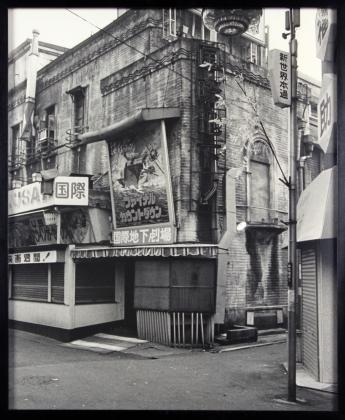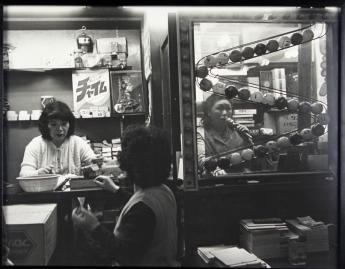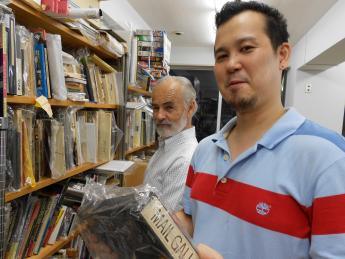Actualités
Book Scouting in Japan - Introduction: The Back Story

By Harper Levine
In April 2008 I traveled to Japan to exhibit at the Tokyo Antiquarian Book Fair. I had lived and taught English in Sapporo, Japan, in 1992, after graduating college, but I hadn’t been back since. The book fair was a convenient excuse to go on a book buying trip. My infatuation with Japanese photobooks was in full bloom. I had handled all the classics, like Bye Bye Photography, Sentimental Journey, and Killed by Roses, but I was curious what little-known gems I might find wandering the backalleys of Jimbocho, the book neighborhood of Tokyo.
I had been given an annotated map of Jimbocho by my friend Kazu Yamaji, owner of Flying Books in Shibuya, and I was raring to go. For those of you who have never been to Tokyo, there is no better book city on earth. In Jimbocho alone there are hundreds of bookstores selling all kinds of books, from high end literature and art, to magazine shops with back issues of Brutus Trip and Music Life neatly ensconced in cellophane wrappers.
There were a few books I was particularly interested in finding. I had sold several copies of Kazuo Kitai’s great protest books, Resistance and Sanrizuka, but I was hoping to find other, more obscure publications by him, or even perhaps some original photographs. On the second day I followed the map and walked into an unmarked building and up a flight of stairs. The smell of cigarette smoke was thick in the stairwell. Deep on the third floor was a small shop called Ramasha (I think). It was crammed with books and printed matter. Immediately I noticed some interesting photographs mounted on posterboard displayed in a glass case. I couldn’t believe my luck when the owner told me they were by Kazuo Kitai. I bought the photographs, and about 30 books, and struggled back to my hotel on the subway.
A few days and many purchases later, it was time to set up for the book fair. On the opening night I was standing in my booth when a dapper, mild-mannered gentleman introduced himself. He seemed to know who I was. It was Hiroshi Masaki, photographer, and executive at the Japanese book firm Maruzen. Hiroshi was friends with Kazuo Kitai and had somehow gotten wind of my interest in his work. (Word travels fast in Jimbocho.) In short order he had arranged a meeting with Mr. Kitai at the Imperial Hotel to look at photographs. Kazuo Kitai has enjoyed a long and distinguished career in Japan, but he remains relatively anonymous in the west, despite the recent popularity of his aforementioned books. (Sanrizuka will be included in the upcoming Steidl Protest Box; that should help buoy his reputation.) Before I met Mr. Kitai, I had pegged Resistance as a forerunner of the Provoke movement. I was not surprised to learn, therefore, that Daido Moriyama and Takuma Nakahira were fans of Mr. Kitai’s work, and Nakahira in particular had spoken to him at length about joining Provoke.
During that first meeting, with Hiroshi translating, I had the pleasure of being shown original vintage prints not only from Sanrizuka, but also from a series called Barricade that Mr. Kitai had neither exhibited nor published. These were images primarily of student protests in Tokyo in 1968, and included shots of demonstrations and marches, with very personal close-ups of items like protestors’ boots, umbrellas, and even rolls of toilet paper. The juxtaposition of the documentary and the intimate was captivating, and I decided right there, in the lobby of the hotel, that Harper’s Books would publish a book of this work and invite Mr. Kitai to have his first exhibition in the United States.
I traveled to Japan again in 2009 and met Mr. Kitai at his home outside Tokyo. Photographs, ideas, and e-mails have been exchanged, and Hiroshi Masaki has worked tirelessly as the interlocutor between an esteemed Japanese photographer and an American rare book dealer. At some point I realized I had no publishing experience and I would need the assistance of an expert. Few American photographers have been more influenced by Japan than John Gossage. One needs only to visit John’s library in Washington DC to understand the extent of his commitment to Japanese photographers and photobooks. It became apparent to me that John’s involvement in this project was crucial to its success. Gossage and Mr. Kitai share many similarities. They are roughly the same age; they started young; both have published scores of books and have publishing companies of their own; the list goes on. Given John’s intrinsic understanding of Japanese photographic literature, I thought it would be perfect symmetry if he designed Mr. Kitai’s book. (Plus he’s really good at it.)
I had hoped to have Mr. Kitai’s book finished and his exhibition this year, but a combination of scheduling conflicts and the tragic earthquake and tsunami in March have postponed both the book and the exhibition until the summer of 2012. As a result of the amended timetable, Mr. Kitai and I decided it would be a wonderful addition to the project if John contributed a series of photographs to accompany Mr. Kitai’s work. Which brings us to today.
On Saturday, Gossage and I will leave for Tokyo, and then Okinawa. While there, we will indulge our common love of books by going to as many shops as is humanly possible in a short span of time, and John will shoot along the way. (Or maybe it’s a full day of shooting and we will scout books along the way.) We have an outing planned with Mr. Kitai in Funbashi, a Tokyo suburb; the photographers will meet and take pictures together. Gossage and I will also travel to Okinawa, the scene of several great Japanese protest books, including Shomei Tomatsu’sOkinawa, and Osamu Nagahama’s, A Long and Hot Night in Okinawa. We will be joined by Yasunori Hoki, whose imprint Super Labo has produced over a dozen excellent photobooks, including work by Gossage, Daido Moriyama and JH Engstrom, among others. In Okinawa, we are honored to meet with Shomei Tomatsu, the dean of Japanese photography.
During the trip I will post numerous updates to this blog. Thanks for looking, and I hope you check back to read about the books we’ve bought, the photographs John and Mr. Kitai have shot, the food we’ve eaten, and whatever else a book dealer and a photographer can cook up over 10 days in Japan.
To be continued.
The article is published on Harper’s Books Blog. It is presented here by permission of the author.



